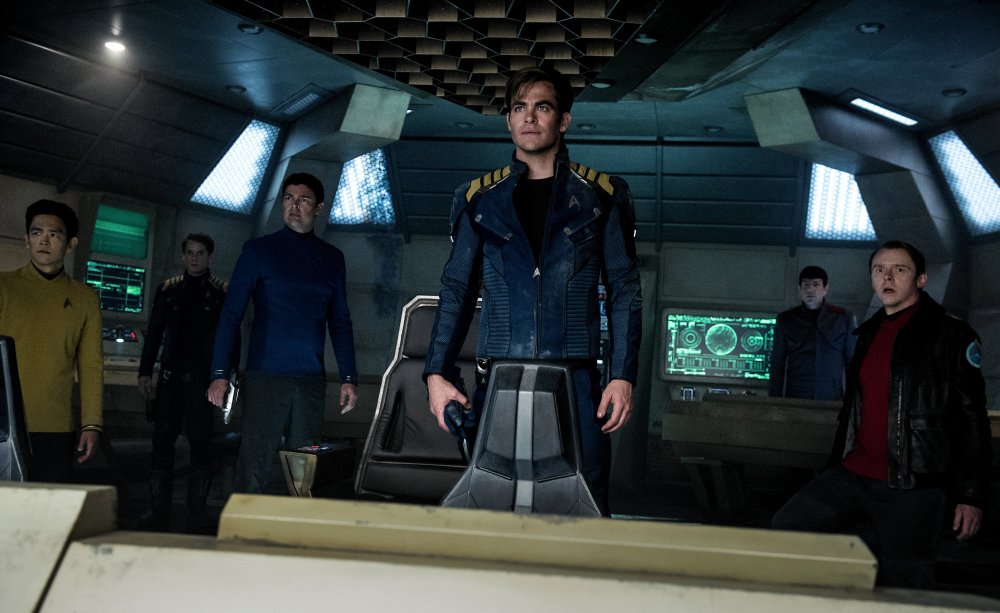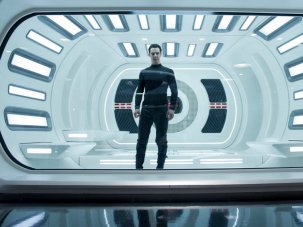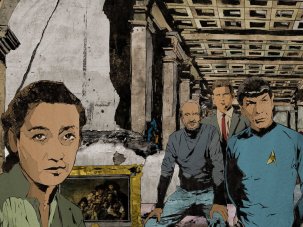This third iteration of a rebooted franchise, following J.J. Abrams’ Star Trek (2009) and Star Trek into Darkness (2013), has to acknowledge the passing of series veteran Leonard Nimoy – as news reaches this Spock (Zachary Quinto) that his parallel universe doppelganger (sole survivor of the ‘original’ Star Trek timeline) has died – and also tweak the end credits in the light of the death of comparatively recent regular Anton Yelchin. When Spock receives his counterpart’s small box of mementoes, he takes a lingering look at a still of the original series cast retrieved from the continuity overwritten by the timewarping of Abrams’ films.
USA 2016
Certificate 12A 122m 14s
Director Justin Lin
Cast
Sulu John Cho
Montgomery Scott, ‘Scotty’ Simon Pegg
Captain James T. Kirk Chris Pine
Commander Spock Zachary Quinto
Lieutenant Uhura Zoë Saldana
Dr ‘Bones’ McCoy Karl Urban
Pavel Chekov Anton Yelchin
Jaylah Sofia Boutella
Krall Idris Elba
Manas Joe Taslim
Kalara Lydia Wilson
Dolby Atmos
[2.35:1]
Some screenings presented in 3D
UK release date 22 July 2016
Distributor Paramount Pictures UK
startrekthemovie.co.uk
► Trailer
A fairly underheated element of Simon Pegg and Doug Jung’s script is the possible break-up of the new team, with Kirk (still suffering from Daddy issues that are likely to recur, since Chris Hemsworth – briefly seen as Kirk Sr two films ago – has signed up for the next instalment) considering a non-flying rear admiral job and Spock estranged from human girlfriend Uhura because he feels a responsibility to further the endangered Vulcan race by seeking a mate from his destroyed homeworld (without getting into the complications of the Vulcan mating urge from the well-remembered Amok Time episode). After this new adventure, both men quietly drop these ideas – just as Quinto and Chris Pine renegotiated their contracts to stay with whatever version of the Enterprise rolls out of dry dock to replace the one trashed here.
Gene Roddenberry’s original Star Trek conception (which may have been influenced by the 1956 film Forbidden Planet) was a spacefaring science fiction series with a uniformed ensemble (his other writer or producer credits include cavalry, cop and military shows like The Lieutenant, Police Story and West Point). Realising he was stronger on the uniform elements – chain of command, differences between officers, the bonding of men in combat – than the idea-intensive business of creating ‘strange new worlds’, Roddenberry hired name science fiction writers like Theodore Sturgeon, Richard Matheson, Robert Bloch and Harlan Ellison to contribute scripts. Over the course of five or six series and three not-quite separate film franchises, the science fiction elements have withered away – the show attracted a fandom in the first place because of the characters and the furniture (the Enterprise), not the ideas.
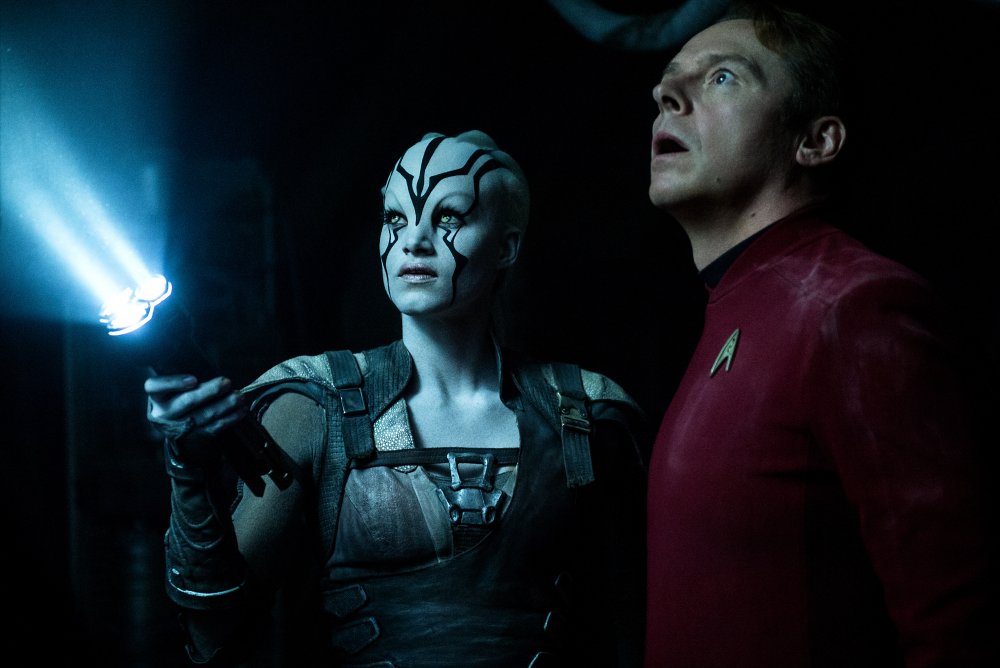
In contrast with Abrams’ films, which set out alternate versions of scenarios from the old series (Into Darkness reworks Star Trek II: The Wrath of Khan), this coins a Roddenberry-esque idea. Rather than the mutated Earth space probe V’Ger of Star Trek The Motion Picture, a mutated Earth space captain (Idris Elba snarling as a lizard-skinned morphing semi-vampire) reappears as a major threat. A quite subtle revision is made: longtstanding criticisms of the military bent of Roddenberry’s utopia are addressed by having an actual violent militarist complain that his conflict-based way of life was wiped out to make way for the ‘unity’ of the Federation (the way this Star Trek franchise wiped out the older ones?) and a blunt statement that Starfleet is not a military force (though it still packs photon torpedoes).
It’s actually refreshing for a big-screen Star Trek to have a ‘regular episode’ feel, though (i) Elba’s Krall is yet another in a line of snarling one-use-only big bads, (ii) giving Pegg his head as writer and actor mostly means better jokes and a rare case of the female guest star (Sofia Boutella) bantering with someone other than the Captain, and (iii) importing director Justin Lin from the Fast & Furious franchise turns out to be a very mixed blessing. This has well-realised outer-space environments – Krall’s mushroom-look encampment, the topsy-turvy city-sized space station – which feel like photorealistic versions of the matte paintings from the 1960s show and manages some spectacular crash-and-battle action. (By now the destruction of the Enterprise has become a running joke, but the version here is splendid.)
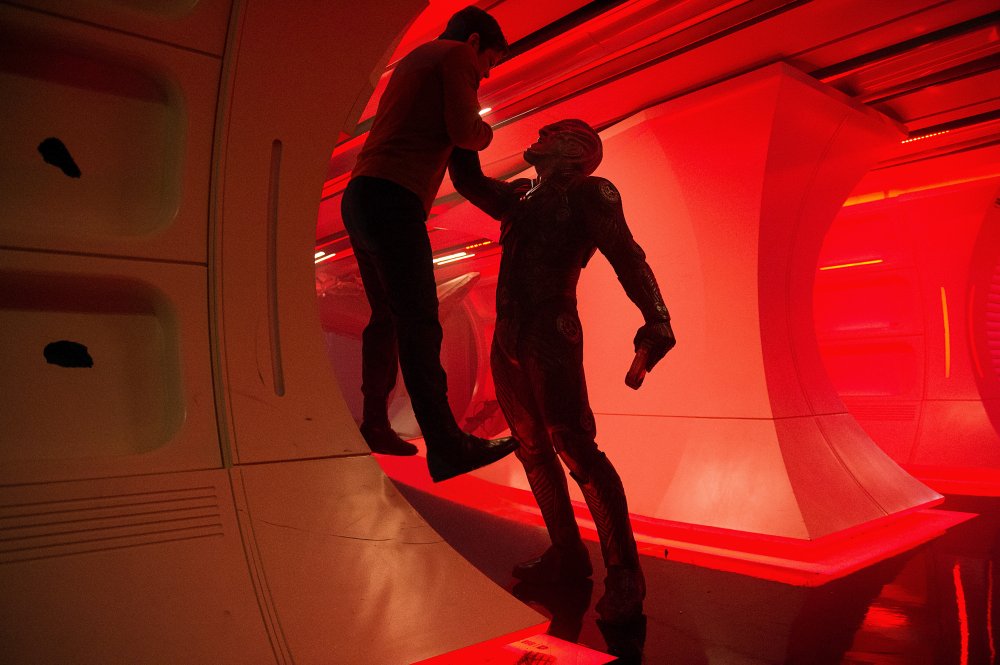
But jittery, swooping camerawork ill-serves many action sequences – chopping things up and looking from odd angles means it’s hard to tell what heroes and villains are actually doing. Compare the grit, suspense and involvement of Arena, the 1969 episode in which William Shatner’s unarmed Kirk battles a reptile enemy on an alien world with the fate of his crew in the balance, with the noisy, busy, what-the-hell’s-going-on? blur of most fight scenes here. It diminishes big characters like Kirk and Spock to lose them in clouds of pixels and rapid edits – though Abrams’ casting decisions are mostly paying off in the long-term. Karl Urban especially catches DeForest Kelley’s incredulous, irascible tone (“You gave your girlfriend radioactive jewelry?”) and Pegg the writer is savvy enough to partner him with Quinto’s dry, wry Spock (who follows an often-repeated Nimoy gambit by breaking stoneface for a hearty laughing scene).
Next time, though – how about getting a science fiction writer rather than a Star Trek fan to script the thing?
-
The Digital Edition and Archive quick link
Log in here to your digital edition and archive subscription, take a look at the packages on offer and buy a subscription.




